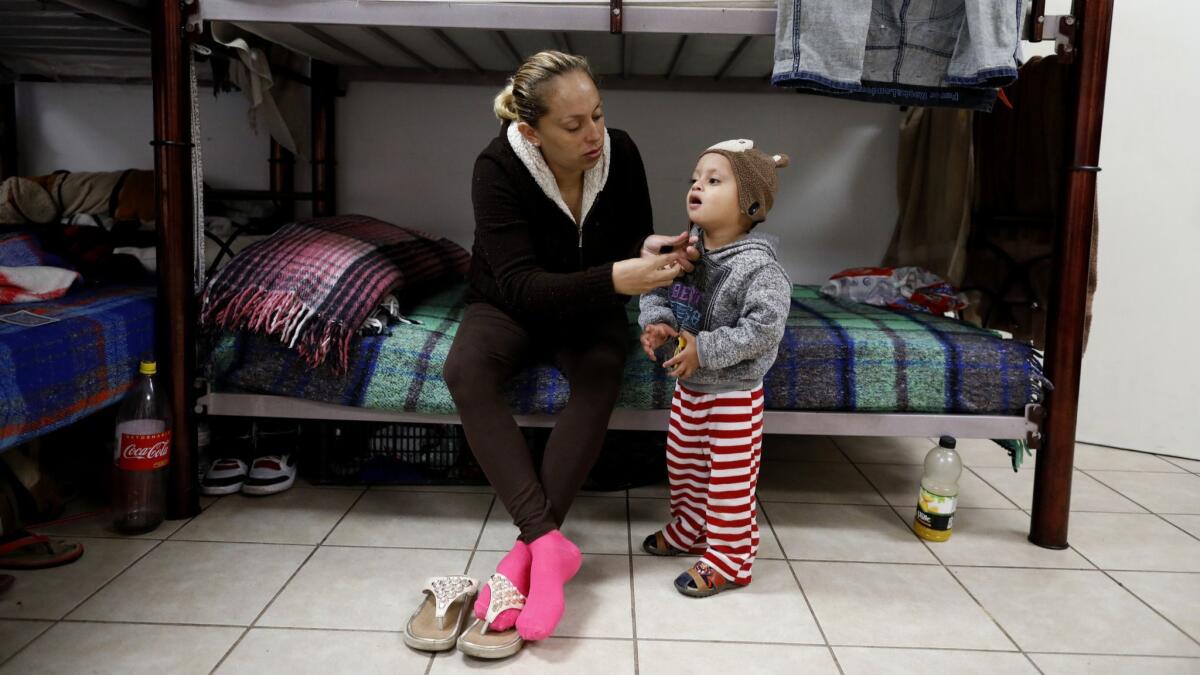Immigrant asylum claims increase at U.S. southern border

- Share via
Reporting from Houston — Pressing its case for restrictions to limit asylum claims, the Trump administration reported Monday that the number of migrants filing such claims at the southern U.S. border has risen sharply this year.
A total of 92,959 migrants filed for asylum during the fiscal year that ended in September, a 67% increase over the 55,584 claims in the 2017 fiscal year, according to data released by U.S. Customs and Border Protection.
The jump is due in large part to an increase in migrants attempting to enter the United States. But the share claiming asylum also rose — from 13% to 18%.
The data were released a day before Kevin McAleenan, the customs and border protection commissioner, was scheduled to testify before a Senate oversight committee, where he is expected to make the case that his agency lacks the resources to process asylum seekers at the border.
The spike in asylum seekers is “straining border security, immigration enforcement and courts, and other federal resources,” he said in a statement Monday.
“As the majority of these claims will not be successful when they are adjudicated by an immigration court, we need Congress to act to address these vulnerabilities in our immigration system which continue to negatively impact border security efforts,” it said.
The Trump administration has been pushing to reduce asylum claims, which must be based on a “credible fear” of persecution or harm on account of race, religion, nationality, political opinion or membership in a “particular social group.”
In June, then-Atty. Gen. Jeff Sessions issued a ruling that being a victim of gang violence or domestic violence would no longer be a valid basis for filing for asylum. More recently, federal courts have blocked the government’s proposal to prevent claims from people who cross the border illegally.
Immigrants may claim asylum when they arrive at the border or later when they’re transferred to Immigration and Customs Enforcement. Those deemed by asylum officers to have a credible fear of returning to their countries are referred to immigration court and either released or moved to federal detention to await an asylum hearing.
Among asylum claims filed at the southern border over the last fiscal year, 40% were filed at border crossing stations while the rest were made after migrants cross illegally and were apprehended.
Well over half the asylum claims from those who crossed the border illegally came from migrants entering Texas’s Rio Grande Valley, the most popular illicit crossing in recent years.
Asylum claims are likely to continue to rise this fiscal year with applications expected from members of the migrant caravan that traveled from Hondurans and arrived in Tijuana last month.
The government has not released equivalent data on asylum claims in previous years, but officials said they were extremely rare before 2013, when large numbers of families from Central America began showing up on the southern border. Such families continue to make up the majority of claims.
Immigration judges denied 65% of asylum cases during fiscal year 2018, according to Syracuse University’s TRAC database, which compiles data from federal immigration courts. Success and failure rates vary widely among different immigration courts. Asylum seekers with attorneys fare much better; the government does not provide lawyers.
During a background briefing Monday, Border Patrol officials told reporters that processing areas at border crossings were too small and “outdated” to handle the influx of asylum seekers.
“The entire immigration system is beyond capacity,” one official said.
The Trump administration says immigrants have been filing baseless claims for asylum so they can stay in the U.S. legally as their cases languish in backlogged immigration courts.
But immigrant advocates attribute the increase in asylum seekers to persistent violence in Central America. They say that new administration policies have resulted in asylum seekers being turned away from border crossings before the legitimacy of their claims is even considered.
In particular, they have condemned a U.S. Customs policy of stationing officers on busy border bridges to prevent asylum seekers from crossing until they join waiting lists maintained by Mexican authorities, a process that can take months.
The practice, known as “metering,” results in asylum seekers being turned away and forced to pay bribes in order to cross legally at ports of entry, according to research released Monday by the University of California San Diego and the University of Texas at Austin.
Last month, The Times documented several cases of asylum seekers who said Mexican immigration officials demanded they pay to cross border bridges, and Mexican officials said they were investigating.
Greg Chen, director of government relations for the American Immigration Lawyers Assn., challenged the government’s argument that it cannot handle the current pace of asylum claims.
“We are at an all-time high of resources being devoted to the border,” he said. “…We are the wealthiest nation in the world. For us not to be able to afford to process people at the border is laughable.”
More to Read
Sign up for Essential California
The most important California stories and recommendations in your inbox every morning.
You may occasionally receive promotional content from the Los Angeles Times.











